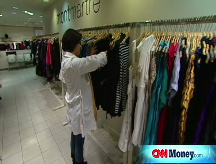Little secrets of 'out-of-business' sales
Do 'closeout' sales mean the lowest prices? Not always. And where did all that extra merchandise come from?
NEW YORK (CNNMoney.com) -- They're seen as either big-time bargains or big-time scams. What really goes on at a "going-out-of-business" sale is something in between, according to experts.
"Consumers think this is the time for bargains. That's not true," said George Whalin, president and CEO of Retail Management Consultants.
Thousands of retail stores are expected to disappear in 2009. But most big chains don't run those out-of-business sales themselves - Linens 'N Things, Whitehall Jewelers and, most recently, Circuit City, all hired liquidation firms to handle the process for them.
The liquidator buys the merchant's inventory and sets final clearance sales. They guarantee the store's creditors a payment upfront, and need to sell enough merchandise to recoup money for themselves.
"Would I love to offer a 60% discount and be out in two weeks? Yes. But it's not likely," said Jim Schaye, CEO of Hudson Capital Partners LLC, one of four firms managing the liquidation of electronic retailer Circuit City.
He said he and the other liquidators needed a "fairly sizeable" recovery in order to help Circuit City repay its creditors.
"We want to make sure everything is fairly priced," he said. "Do we get it right every time? No."
Because the liquidators don't want to lose money, it's not uncommon for clearance sales to begin at 10% to 30% off for the first few weeks, with deeper discounts staggered over the period closer to the end of the closeout sale.
However, Whalin said liquidators sometimes set those discounts based on manufacturers' prices - which can be 10% to 15% higher - rather than the price at the store when it closed.
Consequently, he said, consumers could end up paying more than they would have just before the "out-of-business sales" signs went up.
"This isn't necessarily right. It's almost a scam and there's nothing illegal about it," said Marshal Cohen, chief retail analyst with NPD Group. "Buying at a liquidation really is caveat emptor."
Cohen's suggestion to consumers: "You'll get the absolute best prices a week before [a retailer's] liquidation sale start." Assuming you can get to the liquidating store ahead of the sale.
Andy Gumaer, CEO of Great America Corp., which also is handling Circuit City's liquidation, said his company is setting discounts off the store's price prior to liquidation. He said he would honor prices in Circuit City's final sales circular.
Liquidators looking to make a few extra bucks sometimes sneak in goods that aren't part of the merchant's original inventory and add it to the mix, according to Whalin.
"This happens frequently in furniture liquidation sales," he said.
Hudson Capital's Schaye, who was involved in closing out Mervyns and Linens 'N Things stores, said he's aware of stores that added merchandise, but that he personally "doesn't like the practice."
Cohen said liquidators also go all out to make products less identifiable as "refurbished" or "previously opened."
"Just be aware of that because most liquidation sales are final," Cohen said.
One thing common to liquidation sales is that the discounts grow as the liquidators near the deadline for closing the stores.
"Anyone who has looked at liquidation sales knows that they are staggered over time," said Edgar Dworksy, a consumer advocate and editor of Consumerworld.org. "This isn't new."
He advised consumers to do their research. "Is a 10% discount at Circuit City better than anything else out there? Don't buy if it's not because you have zero percent return rights [in a liquidation]," he warned.
In general, Dworsky cautioned that he wouldn't "put anything past liquidators" when it comes to "playing a game with pricing."
Gumaer's advice to bargain hunters is that they have to decide themselves when to bag a deal.
"You have to take a chance. You can wait for better discounts, but the product may not be there," he said. "In truth, consumers dictate the discounts. If products aren't selling, we'll go deeper." ![]()


